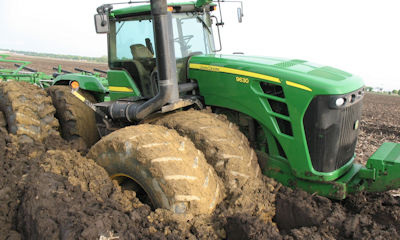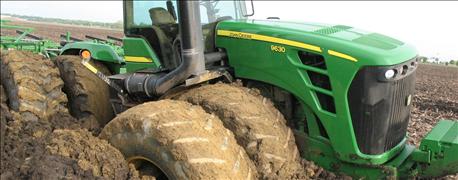
I’ll never forget my first day as a summer intern for Joe Park, then vo-ag teacher and FFA advisor at Indian Creek High School near Trafalgar. The FFA owned farm equipment and rented farm land at the time. Our first ride together was to a field where one Allis-Chalmers was buried in a mud bog to the axles, and our mission was to get it out using another tractor.
I don’t remember all the details - just remember that it was an ordeal. Fortunately, we didn’t do anything stupid - at least not dumb enough to damage the equipment or worse yet, injure one of us.

ASSESS THE SITUATION CAREFULLY: Unless you have the proper equipment and enough horsepower, the best way out of this mess may be calling a professional towing service. (Photo courtesy Fred Whitford)
Fred Whitford, director of Purdue University Pesticide Programs, says that these incidents don’t always turn out that well. He prepared a publication about the do’s and don’ts of getting stuck equipment out of the field.
Related: What you should know about the pesticide applicator recertification program
Spring is coming but February and most of March stand in the way. There is nitrogen to apply to wheat, fertilizer to spread and then weeds to spray. Spring conditions can be tricky, and it’s not difficult to get stuck even if you think you’re on solid ground.
If you’re stuck, here are five things NOT to do.
1. Keep going after your chains break.
It’s time to call a professional with a wrecker if you break chains, ropes, or tow straps before you get it out.
2. Keep going when tempers flare!
Remember that fools rush in where angels fear to tread. When tempers flare, Whitford says poor judgment usually follows. It’s time to take a break, and seek professional help.
3. Keep going only by stringing multiple chains or ropes together.
If you can only get close enough, without getting the rescue vehicle stuck, that you have to string multiple chains ropes or two straps together, you’re likely asking for trouble, Whitford says. Call the pros for help.
4. Keep going even if the only option appears to be getting a running start with the towing vehicle.
There is a reason why it’s recommended that you tighten up the strap or rope before you actually start trying to pull out whatever is stuck. When you try flying starts, you risk jerking chains or straps in two. Bad things happen when chains or straps break and recoil, Whitford says. It’s time for guys with a bigger truck that do this for a living!
5. Keep going even if you don’t know rated capacities for the equipment you’re using.
Straps, clevises and chains all have rated capacities for how much they can tow. Just because you have a bargain tow strap you bought at a flea market doesn’t mean you ought to use it! Call a professional!
Ask your county Extension educator how to get a copy of Whitford’s publication, PPP-98, ‘Extracting stuck equipment safely.’
And all the things above that you shouldn’t do? Every one means realizing it’s time to call for a professional towing service. “It’s difficult to admit when a situation has beaten you,” Whitford writes in the publication. “But carefully reassessing the situation will determine the proper course of action. Listen to what your ‘gut’ instincts tell you. If you don’t feel comfortable doing it, then don’t!”
About the Author(s)
You May Also Like




